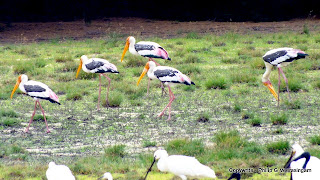 |
| A varied collection of birds. |
 |
| Ibises in flight. |
 |
| Black-winged Stilt. |
 |
| Painted-Storks. |
Video:-
http://www.youtube.com/watch?v=Ben1xU2fU-A
 |
| A varied collection of birds. |
 |
| Ibises in flight. |
 |
| Black-winged Stilt. |
 |
| Painted-Storks. |
 |
| Building housing the 'Ther' |
 |
| The 'Mandapam' |
 |
| A devotee |
 |
| The 'Gopuram' |
| Sir Paul. E Pieris, who also discovered Kadurugoda, made important discoveries here, which have subsequently been identified as belonging to the period of the first Lambakarna King, Vasaba (65 - 109 AC). An inscription on a gold plate records the words "Hail in the reign of the great king, Vasaba and when the Minister Isigirayan was governing Nakadiva, Piyagutikatissa caused a Vihara (temple) to be built at Badakara Atana". The origin of this temple, like most, is founded in legend. The story says that Lavalli Ammaiyar, a pious lady, had been afflicted with nagadosham (a curse) and was hence unable to have children. She was advised to go to this place which was sacred to Vishnu and beseech him for the remission of her sins. She performed tapas (prayed) daily with arms outspread facing the sea in the hope that Lord Vishnu would appear before her, arise from the ocean and grant her desire. One day when the fishermen of the village were fishing they cast their net and caught a large fish which leapt into the arms of Lavalli Ammaiyar. As she held it, it turned into the shape of an infant looking like the Lord Vishnu himself. When the infant vanished an old soothsayer who was present gave to the people a Vishnu Cakkaram (a disc, symbol of Vishnu), which they decided to install at this place and venerate in commemoration of the event. | |||
| |||
| existed in early times as well. The deity of the temple is called Vallipura Azhvar. Azhvar names are common in Vaishnavite tradition. This place is the first place of settlement in Sri Lanka. Rest of Sri Lanka was populated from this landing place. | |||
| Vallipuram (Sandy City) has a recorded history from the 2nd century BC, in the gold inscription, where the local ruler is named as "Azhagiri", a name confirmed in the Nelugala stone inscription (2nd Century BC). King Vasaba is also thought to be mentioned. The Buddhist list of holy places ("Nampotha") names it as "Vallipuram" or sand city. The exact details of the temple complex are not known, and the famous 'Vallipuram" Buddha statue built with Dravidian sculptural traditions from Amaravati, Andhra Pradesh was found in excavations below the Hindu Temple. The language of the inscription is Tamil-Prakrit, which shares several similarities with script inscriptions used in Andhra at the time. This cultural exchange between the Jaffna Tamils and Andhra Pradesh occurred at the height of Tamil trade in the Sangam period, continuing when the Telugu Satavahana dynasty was at the height of its power from 230 BCE right through when its 17th monarch Hāla (20-24 CE) married a princess from the island.[1][2] Professor Peter Shalk (University of Uppsala), writes " Vallipuram has very rich archaeological remains that point at an early settlement. It was probably an emporium in the first centuries AD. From already dated stones with which we compare this Vallipuram statue, we can conclude that it falls in the period 3-4 century AD. During that period, the typical Amaravati-Buddha sculpture was developed". The Buddha statue found here was gifted to King of Thailand by the then British Governor Henry Blake in 1906. The descendants of Arya Chakravarti married into Kalinga Magha family and created a dynasty of Singai-Aryans and ruled from Vallipuram and renamed it as Singai Nagar. However, no historically useful objects, e.g., inscriptions, art or literary works were left by these rulers, and Paranavithana and other historians claim that they paid tribute to the main ruler of the country. See also S. Paranavithana, ``Vallipuram Gold-Plate Inscription of the Reign of Vasaba. Epigraphia Zeylanica, 4 (1936) 229-236. A full discussion has been given recently by Karthigesu Indrapala, Evolution of an Ethnic Identity,(2005), and in an earlier work, 1965 where Dr. Indrapala argued for a flourishing pre-Christian Buddhist civilization in Jaffna, in agreement with Paranavithana, and Mudliyar C. Rasanayagam's Ancient Jaffna. (http://www.srilankaheritages.com/hindu-vallipuram.html) |